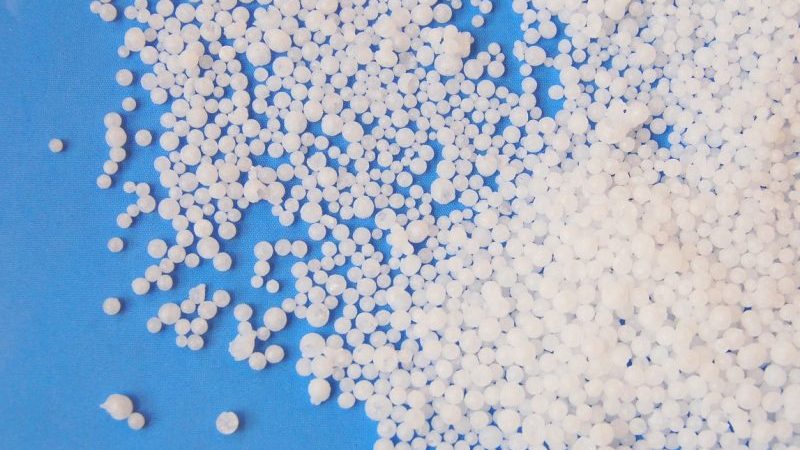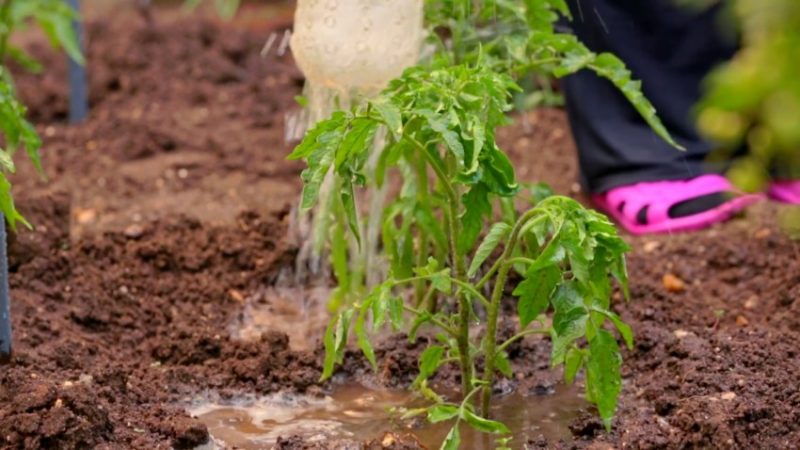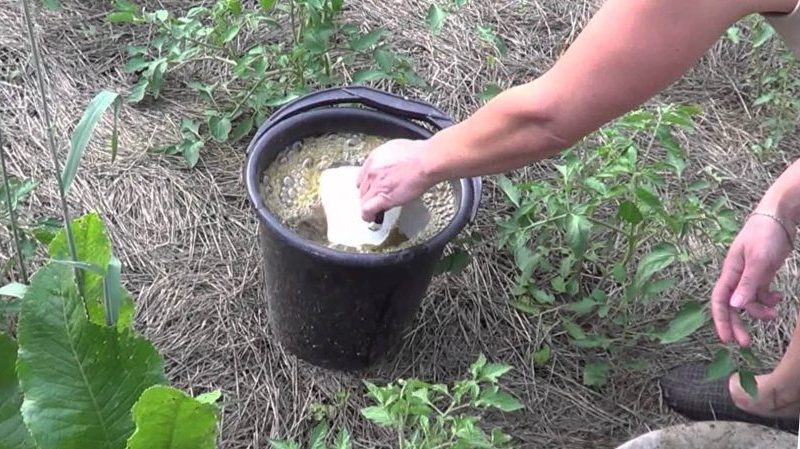Simple rules for a record tomato yield - feeding tomatoes with urea: why is it needed and how to do it
Everyone has heard about the dangers of nitrates - these substances are dangerous to human health. Gardeners try in every possible way to avoid using fertilizers that contain harmful compounds on their beds. Therefore, mineral fertilizers, in contrast to organic dressings, are not very popular among gardeners. How to feed tomatoes so as not to harm the plant and fruits?
Carbamide, or urea, refers to mineral fertilizers that stimulate the growth of tomatoes. How safe it is to use this fertilizer, how to dilute a solution for root, foliar feeding and spraying - you will learn all this from our article.
The content of the article
What is urea
Urea, popularly called urea, is a mineral fertilizer produced in the form of white granules. It contains nitrogen, which is considered essential for healthy plant growth. Of all existing fertilizers, urea contains the highest concentration of nitrogen.
 Fertilizing tomatoes with urea is often used for industrial purposes, in addition, the fertilizer has found application in small greenhouses and greenhouses. Urea is popular because it allows you to control the concentration of nitrates through proper dosage. The compounds that make up it partially evaporate, which prevents the accumulation of hazardous substances in the fruit.
Fertilizing tomatoes with urea is often used for industrial purposes, in addition, the fertilizer has found application in small greenhouses and greenhouses. Urea is popular because it allows you to control the concentration of nitrates through proper dosage. The compounds that make up it partially evaporate, which prevents the accumulation of hazardous substances in the fruit.
Feature... Urea can be used in combination with superphosphate and potassium fertilizers.
The role of urea in the development of tomatoes
When growing tomatoes, urea is used as a top dressing. It is especially important for the full development of seedlings, as it can enhance the growth and productivity of the plant. Fertilizer is involved in the growing season of tomatoes, making the seedlings strong and hardy. Its active components are necessary during the period when the plant grows green mass and the development of the root system. However, it is important not to exceed the recommended dose, otherwise it will harm the tomatoes.
Fertilizer is 50% nitrogen - a substance that helps the plant to become more resistant to diseases and pests. With a shortage of this substance, tomatoes are deformed, and the leaves turn yellow and fall off, which negatively affects the formation of the ovary and fruits.
Benefits of urea:
- complete dissolution in water;
- evaporation of harmful substances;
- does not contribute to the accumulation of nitrates in soil and fruits;
- accelerates the growth of vegetative mass;
- serves as a prophylaxis against diseases and insects.
Disadvantages of urea:
- using a cold solution can stress the plants;
- exceeding the dosage leads to a burn of the seedlings.
How urea works
As soon as urea enters the soil, its active compounds begin to interact with local microorganisms. The reactions produce ammonium from carbon dioxide, which, when released into the open air, is converted to ammonia.
Due to the transformation ability of urea, it should be applied as deeply and in large quantities as possible. The effect of its use is reduced to zero if a little fertilizer was used or it was intended for external feeding.
Feature... Urea is ineffective in alkaline or neutral soil.
Mineral fertilizers are best suited for foliar dressing, since they do not burn the stem and leaves, which cannot be said about saltpeter, which gardeners often use.
Urea is considered unsuitable for use in greenhouseshowever, if used correctly, the fertilizer can be applied in closed beds. This is especially true for soil with excess moisture: urea is more appropriate than saltpeter, since nitrogen is less washed out by rains and groundwater.
When to use urea for tomatoes

Fertilizing tomatoes is necessary at all stages of development, however, at the seedling stage, urea is especially necessary.
Urea must not be added to the soil just before planting: if you put it in the holes, the plant may die. Also, it is not recommended to use it too often.
Foliar top dressing is carried out in early June. Use of urea is prohibited during flowering and the formation of the ovary. Large amounts of nitrogen in the soil can retard fruit development.
Important! Do not water the beds immediately after using the fertilizer.
The soil can be moistened several hours after the introduction of urea. The plant must have time to absorb the beneficial components before they are washed off with water.
How to prepare urea
In the preparation of urea-based feeding, it is important to observe the proportions:
- For applying to the soil for 1 sq. m use 20 g of fertilizer.
- To prepare a solution for irrigation, you will need to dilute 20 g of carbamide in 10 liters of water.
- In a solution for spraying, 30 g of the nitrogen element should fall on 10 liters of water. Experienced gardeners prepare a mixture according to this recipe: 20 g of carbamide is dissolved in 5 liters of water. For 1 bush, 1 liter of fertilizer is enough.
- A liquid solution is also prepared on the basis of urea: 50 g of the substance is diluted in 9 l of water. This amount is calculated for fertilizing a 20 sq. m. Also, this solution is suitable for spraying and feeding adult plants. The mixture is enough to process 50 bushes.
- Urea is used to feed plant roots: 200 g of fertilizer is mixed with 10 liters of water. The mixture is suitable for processing an area of 100 square meters. m. This concentration is often used by industrialists, ordinary summer residents can reduce the amount of fertilizers by 2 times.
- The most used recipe for urea solution is: 1 tbsp. l. fertilizers are diluted in a bucket of water. The mixture is suitable for spraying green mass of plants and foliar dressing. When preparing the solution, you need to use warm water.
Important! An increase in the concentration of urea in the solution may burn the plants.
How to use fertilizer
Urea is used to feed the soil and root system. It is also suitable for spraying tomato leaves.
Planting seeds in a substrate with urea
For the full development of seedlings, urea is introduced into the substrate before planting the seeds. Some make holes, put fertilizer in them, and then plant a seed. Experienced vegetable growers do not recommend this method - it is better to mix urea with all the soil in the planting box.
Moisten the soil before using urea. If it is not possible to water the entire garden, sprinkle the fertilizer with a small amount of soil. For 1 sq. m, 10-15 g of fertilizer is enough.
Watering tomatoes with urea
 When watering tomatoes with a carbamide solution, do not let the liquid get on the leaves. The solution is applied strictly to the root. It is better to do this in the evening to eliminate the risk of burning the plant.
When watering tomatoes with a carbamide solution, do not let the liquid get on the leaves. The solution is applied strictly to the root. It is better to do this in the evening to eliminate the risk of burning the plant.
Leaf spraying
For foliar treatments, a solution is prepared with a weaker concentration of urea. A large tablespoon of fertilizer per 10 liters of water is enough.
Spraying with urea has a good effect on the growth of green mass - the leaves become lush and greener.
Important rules for feeding tomatoes with urea
Urea is a chemical, so when working with it, you need to follow some rules:
- Dilute the solution according to the manufacturer's instructions.
- Water the plants only in the evening.
- Carefully monitor the reaction of tomatoes to feeding.
- Discontinue use at the first sign of burning or saturation of the soil with nitrogen.
Nuances of feeding tomatoes
Urea can be used both in open and closed beds.
In the greenhouse
When using urea in a greenhouse, it is important to consider the location of the beds. If the tomatoes are planted in a permanent place, fertilizer is applied in small quantities, otherwise the plants will experience an excess of nitrogen. An imbalance in the soil will negatively affect the number of ovaries - tomatoes will intensively form foliage and stepsons.
In the open field
When fertilizing tomatoes in open beds, various factors are taken into account: the peculiarity of the soil, the variety of tomatoes, their growth and the formation of ovaries. Usually urea is used during the development of seedlings. Additionally, it is added only if the condition of the plants has deteriorated.
Many gardeners, in order not to get confused, in what period it is necessary to make top dressing, draw up a schedule. However, it is important to consider that at different stages of development, the plant will need different trace elements. Urea is not a universal fertilizer, so it is not recommended to use it all the time. It is better to combine urea with organic and phosphate fertilizers.
Tomato feeding scheme

Fertilization is practiced in areas with soil depletion. In one season, urea can be used 5 times:
- During the period of growing seedlings. 1 g of fertilizer is added to the planting box, and then the seeds are sown.
- When planting seedlings in the garden. Top dressing is applied in a week after planting.
- 3 weeks after planting seedlings. Premature use of fertilizer will lead to violent growth of green mass. At this stage, you can use a mullein and urea solution.
- Top dressing is carried out only if the inflorescences began to fall off. Urea can be diluted with other micronutrient fertilizers for tomatoes.
- Urea is last used during fruiting... It is best to combine urea with other fertilizers - dilute 2 g of urea, potassium sulfate and potassium magnesium in 10 liters of water. After watering, the beds can be sprinkled with wood ash.
Tips & Tricks
The nitrogen in urea can spoil the soil. To reduce the likelihood of soil depletion, lime is used - it neutralizes the effect of nitrogen. For 2 kg of fertilizer, 1 kg of lime is needed.
Lime is used three times throughout the season. For the first time, it is introduced during preparation for planting seedlings, then mixed with urea and introduced during the period of active growth.
Another way to protect the soil from acidification is to add bird droppings, wood ash and superphosphate.
To protect delicate shoots from the aggressive components of carbamide, copper sulfate is added to the spray solution.
Many gardeners use urea as fertilizer after a pick. She, like no other means, contributes to the rapid growth of the green mass of tomato. 1 tbsp. l. urea is dissolved in 10 liters of water and the plant is watered abundantly.
Reviews of vegetable growers
Almost all gardeners who used urea speak positively about it. This tool is strongly recommended by people of the older generation, who began to fertilize their beds with it back in Soviet times. Over time, urea has not lost its relevance, practice has shown that currently produced packages with fertilizers are more convenient to use.
Svetlana, 52 years old: “Urea is an affordable, inexpensive fertilizer that helps grow strong seedlings. I noticed that after using it, tomatoes are more resistant to disease. "
Victor, 72 years old: “I have been using Urea for a long time in the garden. The tool can fertilize the soil, root system and spray. I use it not only for tomatoes, but also for processing garden plants. "
Alexandra, 60 years old: “I feed the tomatoes with urea when the seedlings are growing.When breeding it, it is important to observe the dosage, otherwise the plants may die. "
Conclusion
Urea is one of the most widely used mineral fertilizers. It is safe for plants and fruits. It is important to adhere to the manufacturer's instructions and properly dilute the substance, otherwise the plantings may burn and die. Also, do not abuse urea - this is not the only type of feeding that contributes to the proper development of tomatoes. It is best to dilute urea with other fertilizers so that the tomatoes receive a complete nutrition.